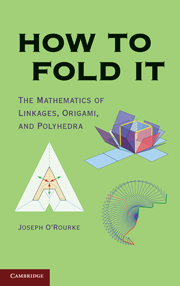Preface
Published online by Cambridge University Press: 05 June 2012
Summary
Cutting out the paper-doll figures below requires 64 straight scissors cuts if done without folding the paper. However, folding the paper along the dashed vertical creases lets you cut out all four people by just cutting one outline in the folded paper. Then you only have to do one-quarter of the work – 16 straight snips of the scissors rather than 64. Noticing that each figure is symmetric about a vertical line through the center of its octagonal head (humans have bilateral symmetry!) and additionally folding along that line permits cutting out all four people with eight straight scissors cuts, now through eight layers of paper. Wouldn't it be nice if there were a way to fold the pattern so that you could get away with a single straight slice of the scissors? Well, believe it or not, there is such a folding!
This beautiful “Fold and One-Cut” result is the topic of Chapter 5 in this book. We will see in that chapter that it is already not so straightforward to cut out a single irregular triangle in the center of a piece of paper with just one scissors cut. But understanding the triangle is a big step toward understanding how to cut out the four paper dolls. Folding the paper in preparation for cutting out a triangle reveals in its creases a theorem we all learned as teenagers (and most of us forgot!): The three angle bisectors of any triangle meet at a single point.
- Type
- Chapter
- Information
- How to Fold ItThe Mathematics of Linkages, Origami, and Polyhedra, pp. ix - xiiPublisher: Cambridge University PressPrint publication year: 2011



